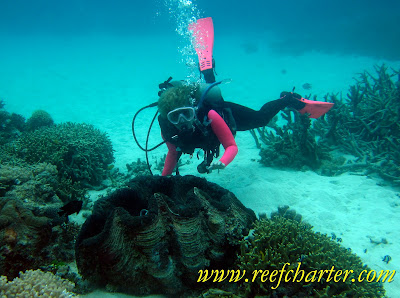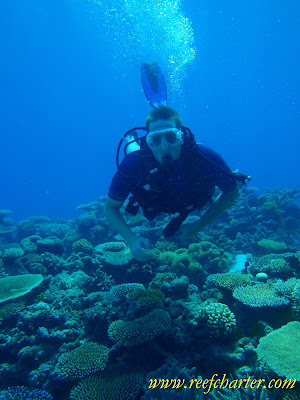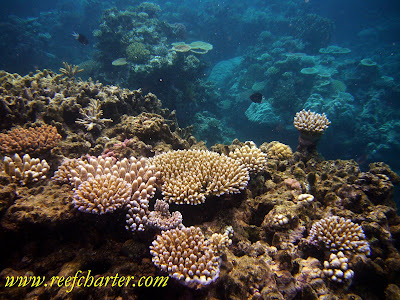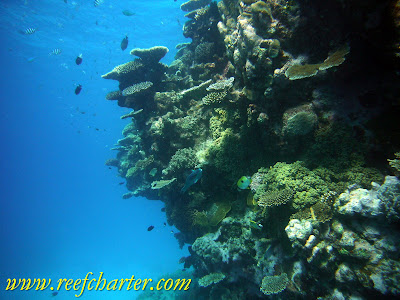We do many things onboard our boats to make sure we minimize our possible environmental impact. That means you can enjoy your diving and snorkeling on the Great Barrier Reef with the knowledge you are not impacting the reef in any detrimental way. One of the things we often talk to our guests about is the use of batteries instead of generators to provide power while we are at the reef.
By capturing energy that would otherwise be wasted during the normal operations of running the engines we charge our extensive battery banks. This allows our snorkelers and scuba divers to enjoy the reef, sunsets and sleep without the noise of a generator in the background. We then recycle the batteries after several years, and eliminating the generator decreases the use of oil and fossil fuels, as well as carbon emissions. A win for both the environment and your travel experience.
So when you are planning your next scuba diving trip to the Great Barrier Reef think about the best way to experience the reef, with only the noise of the waves and birds. If you decide to book with us it’d be our privilege to show you the beauty of this natural wonder…
Category: Environmental Awareness
10 Tips for Seeing the Most While You Scuba Dive
Seeing many scuba divers from all around the world we get to educate our guests on the best way to experience the wonders of the Great Barrier Reef. So to help everyone out wherever you are we put together these tips to help you see more and experience a more interactive diving experience. The best way to see any dive site is with a guide who knows the area and the native wildlife or coral formations in the area. Don’t be afraid to ask them about the site or tell them what you are interested in.
1. Relax and take things slowly when you dive. Remember you are a stranger with lots of bubbles in the underwater world, so by relaxing and not appearing as a threat you will get more fish remaining for you to enjoy.
2. You are in the homes of the fish, turtles and other marine life that you are looking at. Respect that as you would a friends house. Do not disturb the natural surroundings, avoid kicking up sand and definitely not the coral. So practice your buoyancy away from the reef. Give the fish and reef some distance between you and them about 3ft or 1metre.
3. Do not poke, prod or harass the fish. This can be dangerous to their health and sometimes yours. They will also swim away and maybe relocate so other divers will not get to see them later.
4. Always allow the marine life a clear exit path. Make sure you and your dive buddy or group stay to one side and do not surround the animal you are looking at. If the fish or turtle doesn’t feel threatened it will remain for longer and allow you a better experience.
5. Do not feed the fish, apart from it being bad for the natural ecosystem, you do not get to see the natural behaviour of fish if they are being attracted to divers for the food.
6. Move along slowly in the water and pay close attention to the seascape around you. This helps your navigation but more importantly gives you time to really pay attention to the smaller creatures such as beautiful nudibranchs. Initially frightened fish may pop back out or come back to take a closer look at you.
7. Get into routines for checking your gauges. The best equipment designers in the world not make gauge better looking then the reef that surrounds you, so spending time fiddling with your gauges unnecessarily is time wasted. You can play with your dive computer on the boat as much as you want.
8. Spend some time before you get in the water and on the surface to double check you are comfortable with your equipment. Spending time “playing” with your dive gear underwater distracts you form the dive and also makes you consume air more rapidly.
9. Don’t be afraid to stop in a spot to look more closely and examine the coral formations for starfish, crabs and other beauties that make their homes under the coral. Again relax and practice your buoyancy.
10. Stick with your buddy and take the time to point out the cool things you have found. Four eyes are better then two. Agree with your buddy before you dive on some certain types of marine life that you are interested in. By looking at the same type of marine life you both will focus on areas likely to have the creatures.
Most of all have fun, don’t be nervous and we hope to see you diving on the Great Barrier Reef shortly.
How Does a Coral Reef Form?
We even have a picture with labels today, don’t get used to it. This is courtesy of Fiona please see the credits below.
A coral reef is an accumulation of the limestone skeletons of dead reef organisms and the algae that glues them together.
The coral reef builds upwards, growing towards the light much like trees in a rainforest, competing for space and light. Once the coral reef reaches sea level it cannot survive the harsh surface conditions so begins to grow outwards. Creating spectacular formations of coral that spawn further growth and spreading of the reef ecosystem.
Through time, animals grow and the sand, rubble and debris of life is broken down by waves and eroding animals, such as worms and sponges. A complex reef ecosystem is built over time. Today’s underwater gullies and caves were formed because of that erosion. These are the same formations scuba divers enjoy exploring today because they are shelters for an abundance of marine life.
Coral reefs tend to grow where there is a lot of water movement, bringing nutrients, oxygen and new species. Most reef-building corals cannot grow in waters shallow enough to expose them at high tide or deeper than 50 metres, making them highly sensitive to changing sea levels.
The Reef is continually evolving and changing as climate and sea levels change. Healthy, diverse reef ecosystems are more resilient, that is, they are able to adapt to change. The Great Barrier Reef Marine Park Authority is concentrating on maximising reef resilience through research and management.
Thanks to Fiona Merida for this great information. Fiona currently runs the Eye on the Reef Program for the Great Barrier Marine Park Authority. A very successful program that brings together and unites the Great Barrier Reef Marine Park Authority, the Great Barrier Reef tourism industry and the reef research community for the greater good of protecting the reef and educating the community.
A Brief History of the Great Barrier Reef
A lot of our readers have asked for a brief history and background on coral reef formations. I’ll try not to bore everyone. Believe me it makes a better discussion when we are sailing or diving on the reef. The Great Barrier Reef is that like every other ecosystem in world. It’s life-cycle is far greater then man’s living history and we are only just starting to understand this complex underwater world. Most research only dates back 30 years and many data points are close to shore and don’t cover the full extent, depths and variety of coral reefs.
As far as the history of the world goes, reefs appear to be a fairly new phenomenon, only one million years old, a bit older than all of us. The earliest signs of the Great Barrier Reef appeared just over 500,000 years old. Just some background here that a lot of people are unaware of, regardless of what the press etc have been reporting, seas rise and fall naturally and have been doing so since time began. During the rising phase, without human interaction, seas rise about 10m every thousand years. Over the last 500,000 years we have undergone the rise and fall of oceans just under 20 times. The current Great Barrier Reef started growing between 6 and 9,000 years ago, that is when sea levels rose over old underlying reefs and corals started growing. Sleepy yet?
So when the sea level rises the coral reefs take full advantage and often the grow faster then the sea level rises. The coral keeps growing towards the surface, like a plant towards the sun, until the reef flat is exposed at low tides (sea level). When the coral reefs reach the surface, the growth stops or slows and the battle between mother nature and the reef continues. Strong winds, storms, predators, the summer heat, as well as numerous other factors are continually impacting the reef.
So how does the reef survive this continual attack? Well, corals have evolved over thousands of years to survive this delicate ecosystem. So a couple of things:
-When coral spawns it can only successfully seed and grow if the spot it comes to rest on is clean. That means no algae or live coral. So all the damage above actually makes way for the next generation of corals.
– These cycles are natural and the Great Barrier Reef has survived these impacts for hundreds of thousands of years.
– We know from core samples taken around the world that reefs are very resilient to natural events. Only a few species have become extinct over the last 100,000 years.
– Different types of corals grow at different rates so reefs have the ability to reclaim themselves very quickly and then diversify over time as long as there is “seed” coral remaining or another reef nearby.
Coral Reefs build up slowly towards the surface, building upon the growth of previous generations as well as dead coral caused by the impacts above. This is how snorkellers and divers get to enjoy the reefs everyday around the world. By minimizing our impact on the reef we can make sure that this cycle continues.
-Follow reef safe diving and snorkeling practices.
-Reducing major pollutants that have impact on coral growth to ensure that we do not wipe out entire reef systems.
Comparing samples from older reefs to the newer reefs we see that much more damage is happening with much more frequency and to date most reefs have proven resilient. Reefs closer to major human population centres have suffered the most impact. As long as we minimize our impacts, we can be pretty sure that these amazing ecosystems will continue to inspire generations to come.




